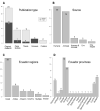Leptospirosis in Ecuador: Current Status and Future Prospects
- PMID: 37104328
- PMCID: PMC10141158
- DOI: 10.3390/tropicalmed8040202
Leptospirosis in Ecuador: Current Status and Future Prospects
Abstract
The location of Ecuador-an equatorial nation-favors the multiplication and dispersal of the Leptospira genus both on the Pacific Coast and in the Amazon tropical ecoregions. Nevertheless, leptospirosis epidemiology has not been fully addressed, even though the disease has been recognized as a significant public health problem in the country. The purpose of this literature review is to update knowledge on the epidemiology and geographical distribution of Leptospira spp. and leptospirosis in Ecuador to target future research and develop a national control strategy. A retrospective literature search using five international, regional, and national databases on Leptospira and leptospirosis including humans, animals, and environmental isolations of the bacteria and the disease incidence in Ecuador published between 1919 and 2022 (103 years) with no restriction on language or publication date was performed. We found and analyzed 47 publications including 22 of humans, 19 of animals, and two of the environments; three of these covered more than one of these topics, and one covered all three (i.e., One Health). Most (60%) of the studies were conducted in the Coastal ecoregion. Twenty-four (51%) were published in international journals, and 27 (57%) were in Spanish. A total of 7342 human and 6314 other animal cases were studied. Leptospirosis was a frequent cause of acute undifferentiated febrile illness in the Coast and Amazon and was associated with rainfall. All three major clusters of Leptospira-pathogenic, intermediate, and saprophytic-were identified from both healthy and febrile humans, the environment, and animals; moreover, nine species and 29 serovars were recorded over the three Ecuadorian ecoregions. Leptospira infections were diagnosed in livestock, companion, and wild animals from the Amazon and the Coast regions along with sea lions from the Galápagos Islands. Microscopic-agglutination test was the diagnostic tool most widely used. Three reviews covering national data on outpatients and inpatients determined the varied annual incidence and mortality rate, with males being more commonly affected. No human cases have been reported in the Galápagos Islands. Genomic sequences of three pathogenic Leptospira were reported. No studies on clinical ground, antibiotic resistance, or treatment were reported, nor were control programs or clinical-practice guidelines found. The published literature demonstrated that leptospirosis was and still is an endemic disease with active transmission in the four geoclimatic regions of Ecuador including the Galápagos Islands. Animal infections, distributed in mainland and insular Ecuador, pose a significant health risk for humans. Nationwide epidemiological surveys-encouraging more research on the fauna and environment with appropriate sampling design on risk factors for human and animal leptospirosis, Leptospira genotyping, increased laboratory capability, and readily available official data-are required to improve our understanding of transmission patterns and to develop effective national intervention strategies with the intention of applying One Health approaches.
Keywords: Ecuador; Leptospira; epidemiology; leptospirosis; neglected tropical disease; zoonosis.
Conflict of interest statement
The authors declare no conflict of interest.
Figures


References
-
- World Health Organization . Report of the Second Meeting of the Leptospirosis Burden Epidemiology Reference Group. World Health Organization; Geneva, Switzerland: 2011. [(accessed on 24 August 2022)]. Available online: https://apps.who.int/iris/handle/10665/44588.
-
- Goarant C., Trueba G., Bierque E., Thibeaux R., Davis B., de la Pena-Moctezuma A. In: In Leptospira and Leptospirosis. Rose J.B., Jiménez-Cisneros B., editors. Springer; Berlin/Heidelberg, Germany: 2019. [(accessed on 24 August 2022)]. Global Water Pathogen Project. Available online: http://www.waterpathogens.org.
-
- Vincent A.T., Schiettekatte O., Goarant C., Neela V.K., Bernet E., Thibeaux R., Ismail N., Khalid M.K.N.M., Amran F., Masuzawa T., et al. Revisiting the taxonomy and evolution of pathogenicity of the genus Leptospira through the prism of genomics. PLoS Negl. Trop. Dis. 2019;13:e0007270. doi: 10.1371/journal.pntd.0007270. - DOI - PMC - PubMed
-
- Torgerson P.R., Hagan J.E., Costa F., Calcagno J., Kane M., Martinez-Silveira M.S., Goris M.G.A., Stein C., Ko A., Abela-Ridder B. Global burden of leptospirosis: Estimated in terms of disability adjusted life years. PLoS Negl. Trop. Dis. 2015;9:e0004122. doi: 10.1371/journal.pntd.0004122. - DOI - PMC - PubMed
Publication types
Grants and funding
LinkOut - more resources
Full Text Sources
Miscellaneous

